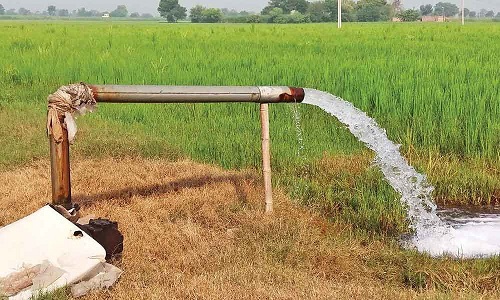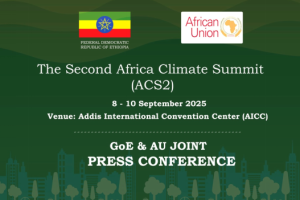
BY EPHREM ANDARAGCHEW
States in the world give due attention to designing various policies and strategies for water resource development. Because water resources are a vital element for the growth and development of a nation. Water resources are imperative for the expansion of small-, medium-, and large-scale irrigation to the extent of possible, hydropower developments to satisfy the energy demand of the upcoming industries and then the water supply and sanitation system for the satisfaction of the inhabitants. Technologies that will enable us to use the water resources will also be used extensively.
Groundwater resource is one of the water resources that the country wants to keep and exploit when things are favorable. Because it is invisible, its impact is visible everywhere. Although groundwater seems out of sight, it is under our feet and is a hidden treasure that enriches lives. Almost all of the liquid freshwater in the world is groundwater. As climate change gets worse, groundwater will become more and more critical.
Scholars and studies of the field advised working together to sustainably manage this precious resource. Groundwater may be out of sight, but it must not be out of mind.
Taking its significance into consideration, World Water Day, held on 22 March every year since 1993, focuses on the importance of freshwater. This year’s theme “Groundwater: making the invisible visible,” draws attention to the hidden water resource that has always been critically important but not fully recognized in sustainable development policymaking.
Groundwater plays a key role in water and sanitation systems, agriculture, industry, ecosystems, and climate change adaptation. Hence, the overarching message of the campaign is that exploring, protecting, and sustainably using groundwater will be central to surviving and adapting to climate change and meeting the needs of a growing population
Ethiopia, like any natural resource, has endowed with groundwater. The groundwater resources potential of Ethiopia is estimated to be about 40 billion cubic meters. It has been used as the main source of water supply since the 1970s for the main cities, towns, and dispersed rural communities across the country, where the provision of reticulated surface-water schemes is often expensive because of initial project construction costs and poor water quality.
Ethiopian Ministry of Water and Energy Minster Dr. Habtamu Itefa said that the use of groundwater resources should be careful and take into account in considering the risk of climate change. Hence, the use of water-saving technologies, rainwater harvesting, and groundwater extraction should be given priority.
Indeed, the exponential growth of the urban population and agriculture-led industrial development has resulted in greater attention to groundwater as the potentially cost-effective water supply source.
As part of the growing focus on the use of groundwater, the Ethiopian government is currently implementing irrigation projects which need the necessary policies, regulations, and investment for infrastructure and capacity development for exploring, exploiting, and managing their groundwater resources.
Various studies have shown that 40 percent of irrigation and agriculture sectors as well as one-third of the industry sector get resources from groundwater. Groundwater is water found underground in aquifers, which are geological formations of rocks, sands, and gravels that hold substantial quantities of water. It feeds springs, rivers, lakes, and wetlands, and seeps into oceans. Groundwater is recharged mainly from rain and snowfall infiltrating the ground. Groundwater can be extracted to the surface by pumps and wells.
It is well recognized that groundwater is important to protect and conserve the biodiversity of the globe. Even we can garner a response when we request why do people use groundwater properly? Life would not be possible without groundwater. Most arid areas of the world depend entirely on groundwater. Groundwater supplies a large proportion of the water we use for drinking, sanitation, food production, and industrial processes. It is also critically important to the healthy functioning of ecosystems, such as wetlands and rivers.
According to the Ethiopian Ministry of Water and Energy Minster State Minister Dr. Asfaw Dengamo, to utilize the nation’s groundwater properly and sustainably, care should be given by all stakeholders. It is also important to carry out extensive watershed development, green legacy, and similar activities tasks across the nation.
Ethiopian Development Partner’s Repres entative Mr. Kitka Goyol in his part noted that since half of the world’s population has access to groundwater to safe drinking water, all stakeholders should work together to achieve groundwater sustainable development. This will help attain sustainable development Goals.
Groundwater is a vital resource and it must be protected from overexploitation and pollution. Exploring, protecting, and sustainably using groundwater will be central to surviving and adapting to climate change and meeting the needs of a growing population.
Belete Berhanu, Yilma Seleshi, and Assefa M. Melesse in their academic article entitled “Surface Water and Groundwater Resources of Ethiopia: Potentials and Challenges of Water Resources Development” stated that in many parts of the country, groundwater is an important source of domestic and industrial water use, especially in rural areas and towns. However, the occurrence of groundwater is not uniform because it depends on various environmental and geological factors.
Hence, the national water sector vision should enhance and promote all national efforts towards the efficient, equitable, and optimum utilization of the available water resources of Ethiopia for significant socioeconomic development on a sustainable basis.
According to the UN World Water development 2022 Report, groundwater resource has huge social, economic, and environmental benefits and opportunities. In Sub-Saharan Africa, the opportunities offered by the vast aquifers remain largely underexploited. Only 3 percent of farmland is equipped for irrigation – compared to 59 percent and 57 percent respectively in North America and South Asia – and only 5 percent of that area uses groundwater.
As the report points out, this low use is not due to a lack of renewable groundwater (which is often abundant), but rather by a lack of investments in infrastructure, institutions, trained professionals, and knowledge of the resource. The development of groundwater could act as a catalyst for economic growth by increasing the extent of irrigated areas and therefore improving agricultural yields and crop diversity
The quality of groundwater is generally good, which means it can be used safely and affordably, without requiring advanced levels of treatment. Groundwater is often the most cost-effective way of providing a secure supply of water to rural villages. However, consideration for future generations and the economic, financial, and environmental aspects of storage depletion should not be overlooked.
The Ethiopian Herald march 27/2022




